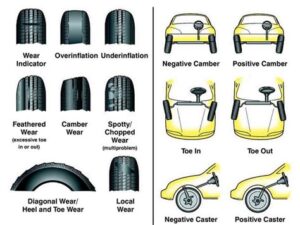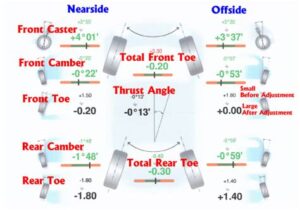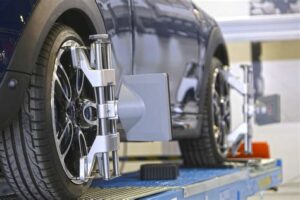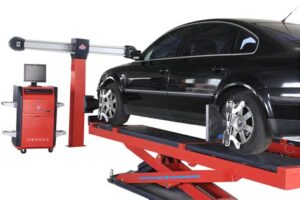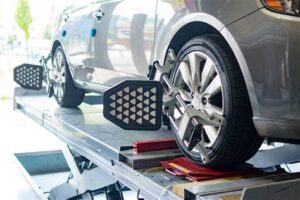Just Got an Alignment? Why Does Your Car Still Pull?
Have you recently had your car aligned only to find it still pulls to one side? You’re not alone in this experience, and it can be both frustrating and concerning. While a proper alignment is essential for optimal vehicle performance, several factors may contribute to persistent pulling despite having taken the necessary steps. In this article, we will delve into the reasons your car might still veer off course, the impact of tire inflation, and the signs that indicate it could be time for further inspection. Additionally, we’ll provide actionable steps to rectify the issue and ensure your driving experience is safe and comfortable. Read on to understand the underlying causes and what you can do to get your vehicle back on track.
Understanding Why Your Car Still Pulls After Alignment
Experiencing a pull in your car even after getting a professional alignment can be frustrating and confusing. Understanding the underlying reasons can help you troubleshoot and address the issue effectively. When you just got an alignment, you might assume that your vehicle should handle perfectly. However, various factors can contribute to the problem:
It’s essential to investigate these possibilities if you notice your car still pulls after receiving alignment services. If you are facing persistent issues, consulting with a professional mechanic may be necessary to delve deeper into the cause and ensure safe driving.
Common Reasons Cars Pull Even After Alignment
Even after you just got your car aligned, there can be multiple factors contributing to continued pulling. Understanding these reasons is essential to ensure your vehicle is safe and comfortable to drive.
Here are some common issues that may cause your car to still pull after an alignment:
- Tire Issues: Uneven tire wear or damaged tires can lead to pulling. Ensure that all tires are in good condition and properly inflated.
- Suspension Components: Worn or damaged parts such as control arms, bushes, or ball joints can affect alignment and cause pulling.
- Brake Problems: If one of the brakes is sticking or applying unevenly, this can cause the car to pull to one side.
- Alignment Settings: If the alignment wasn’t properly adjusted, or if the technician didn’t follow the recommended specifications, the car may pull. It’s important to double-check the alignment settings.
- Drivetrain Issues: Problems with the drivetrain, such as differential issues in all-wheel-drive vehicles, can also lead to pulling sensations while driving.
If you have just got an alignment and are still experiencing pulling, it’s crucial to get further inspection to diagnose the underlying cause accurately.
How Tire Inflation Affects Your Newly Aligned Car
When you just got an alignment, the proper tire inflation is crucial to ensure that your car handles correctly and performs optimally. Tire pressure impacts not just the ride comfort but also affects the alignment results. Here are some important aspects to consider regarding tire inflation:
- Tire Pressure and Handling: If your tires are under-inflated, it can cause uneven wear and affect how your car steers. This can lead to pulling to one side, even after a recent alignment.
- Fuel Efficiency: Properly inflated tires help improve fuel economy. Under-inflated tires increase rolling resistance, which means your vehicle has to work harder – potentially affecting handling and alignment.
- Safety Concerns: Low tire pressure can lead to a blowout or decreased stopping power. A vehicle that pulls due to tire inflation issues is not only uncomfortable to drive but can also pose serious safety risks.
To maintain your vehicle’s alignment benefits, regularly check your tire pressure, ensuring they are inflated to the manufacturer’s specifications. Consider checking tire pressure monthly or before long trips. Monitoring tire wear patterns can also indicate if a tire is inflated correctly, helping you maintain optimal performance.
Signs That Indicate Your Car Needs Further Inspection
If you’ve just got an alignment but your car is still pulling, it may be time to conduct a more thorough inspection. Here are some signs that could indicate a deeper issue:
- Uneven Tire Wear: Check your tire treads for any signs of irregular wear patterns. This could suggest that the vehicle’s alignment is off, or there may be issues with suspension components.
- Constant Pulling: If your vehicle continues to pull to one side consistently, regardless of the driving conditions, it indicates that the problem may be beyond just the alignment.
- Steering Wheel Vibration: Any vibrations or shaking in the steering wheel while driving can suggest that there is a problem with the balance or alignment, necessitating further investigation.
- Unusual Noises: Pay attention to any strange noises when turning or driving, as these could point to problems with the suspension or other related systems.
- Handling Problems: If your car’s handling feels loose or unstable, it could be a sign of worn-out components, requiring immediate inspection.
Addressing these signs promptly can help ensure your vehicle remains safe and performs optimally after you’ve just got an alignment.
Steps to Take If Your Car Just Got an Alignment
If you have just got an alignment and your car still pulls to one side, there are important steps to take to diagnose and resolve the issue effectively:
- Check Tire Pressure: Ensure that all tires are inflated to the manufacturer’s recommended pressure. Uneven tire pressure can cause pulling.
- Inspect Tires: Examine your tires for uneven wear patterns, which can indicate underlying issues with alignment or suspension.
- Revisit the Alignment Shop: If you continue to experience pulling, consider returning to the shop where you had your alignment done. They can double-check their work and ensure the alignment was performed correctly.
- Check Suspension Components: Inspect the suspension and steering components, as worn or damaged parts can affect alignment and cause pulling.
- Test Drive the Vehicle: Take your car for a test drive on a straight and flat road. This helps assess whether the pulling issue persists or varies under different conditions.
- Look for Other Mechanical Issues: Sometimes, problems unrelated to the alignment, such as brake drag or a sticking caliper, can cause pulling. A thorough mechanical inspection is advisable.
- Consider Rear End Alignment: Keep in mind that misalignment can also occur in the rear end, which might cause the car to pull. Ensure that a complete alignment check was performed.
Taking these steps can help you identify the root cause of your car’s pulling after you’ve just got an alignment and ensure a smoother driving experience.
Frequently Asked Questions
What does it mean when a car pulls to one side after an alignment?
When a car pulls to one side after an alignment, it typically indicates that the alignment process did not fully correct the angles of the wheels, or there could be other underlying issues affecting the vehicle’s steering and suspension.
What are common causes of a car pulling after alignment?
Common causes include uneven tire pressure, worn suspension components, faulty brakes, or uneven tire tread wear.
How can I check if my tire pressure is causing the pull?
You can check your tire pressure using a tire pressure gauge. Ensure that all tires are inflated to the recommended PSI listed in your owner’s manual or on the driver’s side door jamb.
Should I take my car back to the shop if it still pulls after an alignment?
Yes, it is advisable to return to the shop that performed the alignment. They may need to recheck their work or investigate other possible causes of the pull.
Can uneven tire tread wear affect my car’s alignment?
Yes, uneven tire tread wear can impact alignment and handling. It’s important to regularly check the tread on your tires and replace them if they show signs of excessive wear.
What is the difference between a wheel alignment and wheel balancing?
A wheel alignment adjusts the angles of the wheels to ensure they are set to the vehicle manufacturer’s specifications, while wheel balancing ensures that the weight of each wheel and tire is evenly distributed to prevent vibrations.
Are there any DIY methods to troubleshoot a pulling issue?
While it’s best to consult a professional, you can visually inspect your tires for uneven wear, check the tire pressure, and ensure that nothing is obstructing the wheels or causing a drag.
